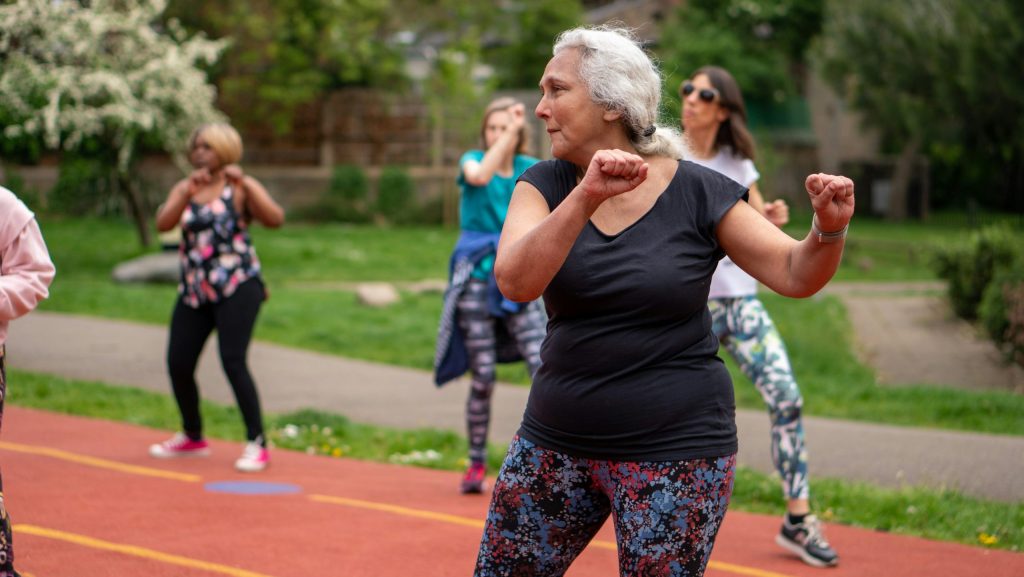Table of Contents
Starting a fitness regimen after the age of 50 is a strategic decision for enhancing physical health and is essential for maintaining vitality as one ages. This stage of life makes it imperative to prioritize health, offering a prime opportunity to initiate or advance a fitness routine tailored to the unique needs of individuals in this age group. Adopting a fitness routine at this age is beneficial for health, aids in disease prevention, and promotes an active lifestyle.
“Did you know? Regular physical activity can significantly reduce the risk of chronic diseases in individuals over 50, according to the World Health Organization.”
Physical activity is key to managing and preventing chronic diseases in those over 50, emphasizing the necessity of incorporating regular exercise into daily routines. The benefits of exercise encompass not just the physical aspects, such as improved muscle strength and cardiovascular health, but also mental and emotional well-being, contributing significantly to overall quality of life.
Key Topics Covered:
- Starting Your Fitness Journey Over 50: Discusses the importance of physical activity for health improvement at this age.
- Essential Fitness Tips for Beginners: Provides practical advice for incorporating fitness into daily routines safely.
- Incorporating Strength Training Safely: Offers guidance on starting strength training to maintain muscle mass and bone density.
- Cardiovascular Health and Endurance: Suggests cardio exercises for enhancing heart health and increasing stamina.
- Staying Motivated and Accountable: Shares strategies for keeping up motivation and tracking fitness progress.
Maintaining an active lifestyle is crucial for those in their 50s and beyond. Fitness at this stage is not only about disease prevention but also about enhancing the overall quality of life. This guide is designed to assist individuals looking to begin their fitness journey, improve their physical health, or explore new active lifestyle options. It provides all the necessary tips and information to help readers safely incorporate fitness into their lives, tailored to their fitness levels.
By following the advice and strategies outlined in this guide, individuals over 50 can take significant steps towards a healthier, more active future. Whether just starting out or looking to enhance an existing routine, this article offers the guidance needed to make informed decisions about fitness and well-being.
Starting a Fitness Regimen After 50: A Practical Guide
Starting a fitness regimen after 50 is a practical decision for enhancing physical health and contributing to a longer, more active life. This period presents a chance to prioritize health, offering opportunities to initiate or advance a fitness routine suited to individual needs at this age. Adopting a fitness routine now is crucial for health, aids in disease prevention, and promotes an active lifestyle.
Engaging in regular physical activity has numerous benefits for individuals over 50, affecting various aspects of health and well-being. Physically, it helps maintain and increase muscle strength, improves balance and flexibility, and reduces the risk of chronic diseases such as heart disease, diabetes, and osteoporosis. Mental benefits include better cognitive function and reduced symptoms of depression and anxiety. Furthermore, participating in exercise groups can enhance social connections, reducing feelings of loneliness.
Benefits of Exercise for Seniors:
| Benefit | Description |
|---|---|
| Muscle Strength and Flexibility | Improved through regular activities like walking and yoga. |
| Mental Health | Enhanced cognitive function, reduced depression symptoms. |
| Social Well-being | Increased through participation in group classes or activities. |
Starting an exercise routine at this age may face barriers, including physical limitations, chronic health conditions, or a lack of motivation. It’s important to consult healthcare providers to understand safe and beneficial activities, taking any health conditions into account. Overcoming psychological barriers is also crucial, as many might feel it’s too late to start exercising or fear injury. It’s beneficial to learn about others who have begun their fitness routines later in life, demonstrating that starting exercise at 50 is both achievable and beneficial.
“Regular physical activity can reduce the risk of heart disease in people over 50 by up to 35%.”
Setting realistic goals is important when beginning a fitness routine. Goals should be specific, measurable, attainable, relevant, and time-bound (SMART), such as aiming to walk for 30 minutes a day, five days a week. Starting slowly and gradually increasing workout intensity and duration can help prevent injuries and ensure a long-term commitment to fitness.
Initiating a fitness journey after 50 is crucial for health improvement and quality of life. Understanding the benefits of exercise, overcoming barriers to fitness, and setting realistic goals are key steps in developing a successful fitness routine. Regular physical activity is essential for achieving better health and a more active lifestyle after 50. By following this guide, individuals can take significant steps towards a healthier future, regardless of their starting point.

Starting a Fitness Routine After 50: A Guide for Beginners
Starting a fitness routine after 50 requires selecting exercises that match one’s health goals, lifestyle, and physical condition. This segment focuses on guiding beginners over 50 through choosing suitable exercises, establishing a consistent exercise routine, and understanding the importance of responding to the body’s signals to avoid injury and promote long-term fitness engagement.
Choosing the Right Activities
For those beginning their fitness journey later in life, prioritizing low-impact exercises is crucial. Activities such as walking, swimming, and yoga are recommended due to their reduced risk of injury and the lower strain they place on the body. These exercises are beneficial for improving cardiovascular health, muscle strength, and flexibility, while also being adaptable to various fitness levels.
Benefits of Low-Impact Exercises:
- Walking: A gentle, accessible way to improve cardiovascular health.
- Swimming: Provides a full-body workout that minimizes stress on joints.
- Yoga: Increases flexibility and balance, and supports mental health.
Incorporating a variety of these activities can prevent boredom, making it easier to stick to a fitness routine. It’s also important to choose exercises that are enjoyable, as this increases the likelihood of maintaining a consistent routine over time.
Creating a Routine
Developing a workout routine involves more than just choosing activities; it requires setting a consistent schedule that integrates exercise into daily life. For beginners, especially those over 50, starting with a manageable frequency, such as three days a week, helps build the habit without overwhelming the body. Over time, as endurance and strength improve, the intensity and duration of workouts can be increased gradually.
A balanced routine should include cardiovascular exercises, strength training, and flexibility workouts. This approach ensures comprehensive health benefits, including improved heart health, stronger muscles, and better mobility. Utilizing tools like fitness apps or a journal to track progress can be motivating and help in recognizing achievements, no matter how small.
“Walking for just 30 minutes a day can significantly reduce the risk of chronic diseases and improve mental health.”
Listening to Your Body
An essential aspect of starting and maintaining a fitness routine is the ability to listen to your body’s signals. Distinguishing between normal exercise-induced discomfort and pain that may indicate injury is crucial. If any activity causes pain, it’s important to stop immediately and, if necessary, seek medical advice. This precaution helps avoid injuries that could derail fitness goals.
Incorporating rest days into your exercise schedule is equally important. Rest days allow the body to recover, reducing the risk of overuse injuries. Additionally, staying hydrated, following a nutritious diet, and ensuring adequate sleep are all practices that support a successful fitness journey.
Beginning a fitness routine after 50 involves selecting appropriate low-impact activities, creating a balanced and consistent exercise schedule, and paying close attention to the body’s feedback. These steps are fundamental for older adults looking to improve their physical health and enhance their overall well-being. By following these guidelines, beginners can build a solid foundation for a healthy, active lifestyle that supports their fitness goals.
Incorporating Strength Training Safely for Seniors
Maintaining muscle strength and bone density is essential for health and mobility in older age. Strength training is an effective method to achieve these goals, and it’s vital for seniors to integrate it into their fitness routines safely. This segment covers the importance of strength training for seniors, outlines safe exercises, and provides guidelines on gradually increasing intensity and adapting workouts to meet individual needs.
Benefits of Strength Training
Strength training is crucial for seniors as it helps maintain muscle mass, which naturally decreases with age. It also improves bone density, reducing the risk of osteoporosis. Benefits extend to enhancing metabolic rate, aiding in weight management, and lowering the risk of chronic diseases such as diabetes and heart disease. Engaging in regular strength training can lead to better balance, fewer falls, and improved daily functioning.
“Regular strength training can increase muscle mass by up to 1-2% per month in seniors, significantly improving mobility and functional independence.”
Safe Strength Exercises
For beginners and seniors, focusing on safe exercises is essential to prevent injuries. Recommended activities include seated chair squats, wall push-ups, and exercises using light dumbbells. These exercises target major muscle groups without excessive strain on joints.
| Exercise | Description | Benefit |
|---|---|---|
| Seated Chair Squats | Sitting down and standing up from a chair | Strengthens legs, improves balance |
| Wall Push-ups | Performing push-ups against a wall | Builds upper body strength |
| Light Dumbbell Exercises | Using light weights for arm exercises | Enhances arm muscle tone and strength |
Progression and Adaptation
As individuals gain comfort and skill with basic strength exercises, it’s important to gradually increase workout intensity to continue building muscle and enhancing fitness levels. This progression can be achieved by adding more weight, increasing repetitions, or incorporating more complex exercises. However, adjustments should be made cautiously, listening to the body’s signals to avoid overexertion.
Adapting exercises is also vital for seniors, allowing for customization based on physical limitations or health conditions. Modifications may include using chairs for balance support, adjusting the range of motion, or lengthening rest periods between sets. Tailoring exercises ensures that strength training remains beneficial and safe throughout aging.
Strength training is a key element of a comprehensive fitness plan for seniors, offering benefits for muscle health, bone density, and overall well-being. By focusing on safe exercises, employing the right equipment, and customizing workouts to individual abilities, seniors can integrate strength training into their routines effectively. Careful progression and adaptation of exercises are essential to maintain safety and achieve long-term health benefits, supporting a more active and independent lifestyle as we age.

Cardiovascular Health and Endurance for Seniors
Cardiovascular health is a critical aspect of wellness, especially for seniors. Regular cardio exercises not only support heart health but also enhance endurance, making daily activities more manageable and improving overall quality of life. This section details the importance of cardio exercises for individuals over 50, presents recommended activities to improve cardiovascular health, and offers advice on balancing exercise intensity to ensure safety and effectiveness.
Importance of Cardio
Cardiovascular exercises are essential for maintaining and improving heart health. For seniors, consistent cardio activities help in managing blood pressure, reducing the risk of heart disease, and enhancing lung function. Moreover, cardio exercises aid in weight management and can decrease the likelihood of developing chronic conditions such as diabetes.
“Engaging in 30 minutes of moderate-intensity cardio exercise, such as brisk walking, five times a week can reduce the risk of heart disease by up to 40% among seniors.”
The mental health benefits of regular cardiovascular activity cannot be overstated. Exercises that elevate the heart rate also release endorphins, contributing to reduced anxiety and depression levels.
Recommended Cardio Activities
For older adults, selecting low-impact cardio activities is crucial to minimize stress on the joints and reduce injury risk. The following are effective and safe options:
- Walking: A versatile and accessible form of exercise, walking improves cardiovascular health and enhances balance. It can easily be adjusted to fit any fitness level.
- Cycling: Whether outdoors or on a stationary bike, cycling is a low-impact exercise that strengthens the heart without excessive strain on the body.
- Swimming: Known for its endurance-building capabilities, swimming offers a comprehensive workout that improves heart health and supports joint health.
Incorporating a mix of these activities into a weekly routine can keep the exercise regimen interesting and maximize cardiovascular health benefits.
Balancing Intensity
Gradually increasing the intensity of cardio workouts is key to safely building endurance. For seniors, beginning with moderate-intensity activities and slowly enhancing the workout’s duration and frequency is advisable. This approach allows the body to adapt without the risk of overexertion or injury.
Monitoring heart rate during exercise and staying within recommended limits is an effective way to ensure workouts remain within a safe intensity range. Additionally, seniors should listen to their bodies and adjust their activities based on how they feel during and after exercise. Consulting with healthcare providers before starting any new exercise regimen is also recommended, especially for those with existing health conditions.
Cardio exercises play a vital role in maintaining cardiovascular health and enhancing endurance for seniors. By choosing appropriate exercises such as walking, cycling, and swimming, and carefully balancing the intensity of these workouts, older adults can enjoy the health benefits of a stronger, more resilient heart. Tailoring cardio activities to individual health needs and capabilities ensures that seniors can safely improve their cardiovascular fitness, supporting a healthier and more active lifestyle.

Staying Motivated and Accountable in Senior Fitness Routines
Staying motivated and accountable is essential for the success of any fitness routine, particularly for seniors who may face unique challenges in maintaining an active lifestyle. This segment provides practical advice on building a support network, tracking fitness progress, and adapting goals to sustain motivation and accountability over time.
Building a Support Network
Creating a network of support can significantly enhance motivation for seniors. Engaging with workout partners for accountability and fitness communities for support offers encouragement and a sense of camaraderie, making the fitness journey more enjoyable and sustainable.
- Finding a workout buddy who shares similar fitness goals can provide mutual motivation and make exercising a social activity.
- Joining fitness groups, either online or in-person, allows for the exchange of tips, experiences, and moral support.
- Participating in group fitness classes tailored to seniors can foster a sense of community and belonging, encouraging regular attendance.
Tracking Progress
The use of fitness tracking for progress is a powerful tool in staying motivated. Documenting workouts, setting fitness milestones, and celebrating achievements can help seniors visualize their progress and stay committed to their fitness goals.
“Individuals who track their fitness progress are 30% more likely to achieve their goals compared to those who don’t.”
- Utilizing fitness apps or wearable devices can simplify the tracking of physical activity, sleep patterns, and other health metrics.
- Keeping a fitness journal can also be a more personal way to record exercises, reflect on progress, and set future objectives.
- Setting achievable milestones and acknowledging every success, no matter the size, reinforces positive behavior and dedication to one’s fitness routine.
Adapting to Changes
As seniors progress in their fitness journey, adjusting fitness goals becomes necessary to align with their current abilities, interests, and health status. Flexibility in goal-setting ensures that fitness remains a rewarding part of their lifestyle.
- Modify intensity or type of exercise: Adjust based on current physical condition, interest, or to prevent boredom.
- Set new fitness milestones: Reflect current abilities and redefine what success looks like at different stages.
- Explore new activities: Introducing variety into the routine keeps it engaging and responsive to changing preferences or needs.
Maintaining motivation and accountability are foundational to achieving and sustaining fitness goals, especially for seniors. Through building a supportive community, diligently tracking progress, and being adaptable in goal-setting, seniors can navigate their fitness journey with confidence and enjoyment. These strategies empower them to stay committed to their health and well-being, leading to a more active, fulfilling lifestyle.
Conclusion: Fitness in 50s: Tips for Beginners
Embarking on a fitness journey after the age of 50 offers a host of benefits, from improved physical health to enhanced mental well-being. This comprehensive guide has provided a roadmap for seniors looking to start or enhance their fitness routines, covering everything from the initial steps to long-term commitment and adaptability.
“Embrace the process of learning, growing, and adapting your fitness routine to reflect your evolving needs and goals. Remember, it’s never too late to prioritize your health and well-being.”
Key Insights from the Article:
- The importance of recognizing the benefits of regular exercise and overcoming initial barriers.
- Selecting suitable activities and establishing a consistent routine that respects individual capabilities and interests.
- Incorporating strength training and cardiovascular exercises into routines safely to maintain muscle strength, bone density, and cardiovascular health.
- The role of motivation and accountability in sustaining a fitness routine, utilizing support networks, and tracking progress.
- The necessity of adapting fitness goals and routines to accommodate personal growth and changing health needs.
Concluding, the journey to maintaining fitness after 50 is both rewarding and essential for health and longevity. It requires understanding the right strategies for starting, integrating strength and cardio exercises effectively, and fostering motivation through support and goal tracking. By applying the advice outlined in this guide, seniors can significantly improve their quality of life, demonstrating that age is but a number when it comes to embracing a healthy, active lifestyle. Implementing these strategies leads to not only physical improvements but also contributes to mental and emotional well-being, proving the timeless value of health and fitness.